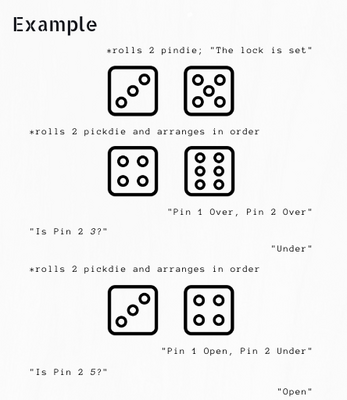
Sneakthief — A Lockpicking Addon
A downloadable module
Delight the rogues, thieves and all who have a casual disrespect for private property in your games by adding an element of realism and real-life skills to picking locks.
Simple enough to teach in 30 seconds and expandable to high difficulties. Easily hacked into any system using 3 lock-difficulty principles. Based on real-world lock picking methodology.
System: None. MOSAIC Strict- and OSR- compatible.
Needed: d6, d8, or d10 depending on game difficulty.
Time to play: 1 to 3 minutes.
Ages: As long as there's no danger of eating the dice.
Cover Image: Lock and Key, Smithsonian Collection, CC0
Uncle Vova CC BY SA 4.0
| Status | Released |
| Category | Physical game |
| Rating | Rated 5.0 out of 5 stars (7 total ratings) |
| Author | atelier pilcrow |
| Tags | Dice, Modular, mosaic-strict, OSR, rules-lite, Tabletop role-playing game |
Download
Click download now to get access to the following files:
Community Copies
Support this module at or above a special price point to receive something exclusive.
Will add 2 CCs for every purchase and 1 CC / Rating
Development log
- now freeJun 06, 2023
- formatting and minor copy editsAug 07, 2022

Comments
Log in with itch.io to leave a comment.
Of course when a character breaks out the magic piack-that-bosnian-bill-and-i-made, the difficulty is immediately lowered by several levels.
Jokes aside this looks cool and I can't wait to try it out.
Maybe I’ll send LPL this game! Do let me know how it goes, and if well, consider giving it some stars :)
Despite having my own little lockpicking procedure I find this very interesting. I am having trouble parsing some of the text though.
What do you mean by:
"until the rounds are over"
"sets them in order left to right"
"The picklock can guess one other pindie's value"
I think I know what you mean but it's a bit unclear.
Hi! Thanks for the feedback. I will see if I can’t make it clearer.
btw I really like how your procedure handles time passing